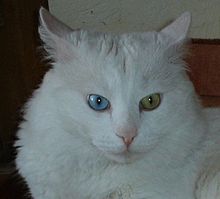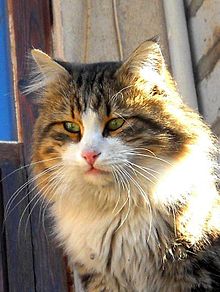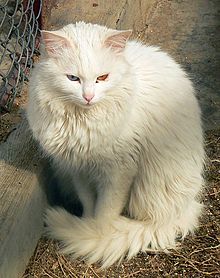Turkish Angora: Difference between revisions
m rm comments in article space (HG) |
|||
| Line 64: | Line 64: | ||
==Genetics== |
==Genetics== |
||
The contents of this section are the opinion of one person, who has been repeatedly charged with misinterpretation of the scientific data he cites. He contests the data interpretation of the scientists who performed the study, with no data to back his position. Phylogenetic trees demonstrate the common ancestry of ALL cats and in no way demonstrates anything other than the origin of all domesticated cat species from one common genetic ancestor. There is therefore no scientific conclusion that can credibly claim the United States-based Turkish Angoras are some other breed. |
|||
A genetic study of pedigree cat breeds (using DNA taken from pedigreed cats in US and Europe)random-bred populations showed the Turkish Van as a distinct population from the Turkish Angora despite their geographical association. <ref>[http://www.sciencedirect.com/science/article/pii/S0888754307002510</ref> On the other hand the phylogenetic tree indicates that pedigree Turkish Angoras are more related to Tunisian random bred cats and Egyptian Mau than Turkish random bred cat populations. Tunisian cats and Egyptian Mau have ''western'' influence: ''Bayesian analysis indicated that Italian and Tunisian cats were an admixture of Western European and Mediterranean cats. This mixing supported the historical ties between Tunisia and Western European countries''(Fig. 3. Factorial correspondence analysis of cat breeds and populations). . ''Egyptian Maus also appear to be on the verge of losing their historical origins via genetic influences from Europe'' |
A genetic study of pedigree cat breeds (using DNA taken from pedigreed cats in US and Europe)random-bred populations showed the Turkish Van as a distinct population from the Turkish Angora despite their geographical association. <ref>[http://www.sciencedirect.com/science/article/pii/S0888754307002510</ref> On the other hand the phylogenetic tree indicates that pedigree Turkish Angoras are more related to Tunisian random bred cats and Egyptian Mau than Turkish random bred cat populations. Tunisian cats and Egyptian Mau have ''western'' influence: ''Bayesian analysis indicated that Italian and Tunisian cats were an admixture of Western European and Mediterranean cats. This mixing supported the historical ties between Tunisia and Western European countries''(Fig. 3. Factorial correspondence analysis of cat breeds and populations). . ''Egyptian Maus also appear to be on the verge of losing their historical origins via genetic influences from Europe'' |
||
<ref>[http://www.sciencedirect.com/science/article/pii/S0888754307002510</ref>. |
<ref>[http://www.sciencedirect.com/science/article/pii/S0888754307002510</ref>. |
||
Revision as of 21:53, 31 May 2012
| Turkish Angora | |
|---|---|
 | |
| Other names | Ankara |
| Origin | Turkey |
| Breed standards | |
| CFA | standard |
| FIFe | standard |
| TICA | standard |
| ACFA/CAA | standard |
| CCA-AFC | standard |
| Domestic cat (Felis catus) | |

The Turkish Angora (Turkish: Ankara kedisi, 'Ankara cat') is a breed of domestic cat. Turkish Angoras are one of the ancient, natural breeds of cat, having originated in central Turkey, in the Ankara region (historically known as Angora). The breed is also sometimes referred to as simply the Angora or Ankara cat, and in some obsolete works as the Angola.[1]
Physical characteristics
Turkish Angora cats have a silky tail, medium-long length coat, no undercoat and a balanced body type.
Although they are known for their shimmery white coat, currently there are more than twenty varieties including black, blue, and reddish fur. They come in tabby and tabby-white, along with smoke varieties, and are in every color other than pointed, lavender, and cinnamon.

Eyes may be blue, green, or amber, or even odd-eyed (one blue and one amber or green).
Ears are pointed, large and wide-set, eyes are almond shaped and the head is massive with a two plane profile. Another characteristic is the plumed tail, which is often carried upright, perpendicular to the back.
Angora and Persian
There seems to be a connection between Angoras and Persians. Persian cat was developed from mutation of Turkish Angora by British and American cat fancies. Although some cat associations think that Persian cat is a natural breed, in the 19th century Persians and Angoras were identical. In 1903, F. Simpson wrote in her book The Book Of The Cat[2]:
In classing all long-haired cats as Persians I may be wrong, but the distinctions, apparently with hardly any difference, between Angoras and Persians are of so fine a nature that I must be pardoned if I ignore the class of cat commonly called Angora, which seems gradually to have disappeared from our midst. Certainly, at our large shows there is no special classification given for Angoras, and in response to many inquiries from animal fanciers I have never been able to obtain any definite information as to the difference between a Persian and an Angora cat.
Genetics
A genetic study of pedigree cat breeds (using DNA taken from pedigreed cats in US and Europe)random-bred populations showed the Turkish Van as a distinct population from the Turkish Angora despite their geographical association. [3] On the other hand the phylogenetic tree indicates that pedigree Turkish Angoras are more related to Tunisian random bred cats and Egyptian Mau than Turkish random bred cat populations. Tunisian cats and Egyptian Mau have western influence: Bayesian analysis indicated that Italian and Tunisian cats were an admixture of Western European and Mediterranean cats. This mixing supported the historical ties between Tunisia and Western European countries(Fig. 3. Factorial correspondence analysis of cat breeds and populations). Egyptian Maus also appear to be on the verge of losing their historical origins via genetic influences from Europe[4].
Inconsistencies: The Turkish random bred cat populations shared similarity with İsrael cats, but not with pedigree Turkish Angoras (The phylogenetic tree). Only a few Ankara Zoo cats were tested. Many pedigree Turkish Angoras are said to be descended from Ankara Zoo cats and must trace back to the earliest imported cats from the Ankara Zoo. The Ankara Zoo cats are selectively bred white longhair Turkish street cats [5]
One of the Ankara Zoo cats Minos of Angorarama [6] sample number 9575 was in the study, however this cat was classified as Van type D, not as Turkish Angora. This contradicts the following findings, claiming that pedigree Turkish Angoras from USA and Europe are most representative cats of Turkey. It was not explained why Ankara Zoo cats did not have similar DNA markers to pedigree Turkish Angora cats. The genetic differences could be induced due to outcrossing, which could take place in early Turkish Angora breeding programs.
History

Like all domestic cats, Turkish Angoras descended from the African wildcat (Felis silvestris lybica). Fertile crescent was a place where first cats were domesticated. Cats from eastern mountainous regions of early Anatolia and through inbreeding and natural selection, developed into longhaired breeds like the Turkish Van and the Turkish Angora{{[7]|date=March 2011}}.
Longhaired cats were imported to Britain and France from Asia Minor, Persia and Russia as early as the late 16th century, though there are indications that they appeared in Europe as early as the 14th century due to the Crusades. The Turkish Angora was used, almost to the point of extinction, to improve the coat on the Persian. The Turkish Angora was recognized as a distinct breed in Europe by the 17th century.[8]
In the early 20th century, the Turkish government, in conjunction with the Ankara Zoo, began a meticulous breeding program to protect and preserve what they considered a national treasure: pure white Turkish Angoras[9]. The program continues today. The zoo particularly prized odd-eyed Angoras (i.e. Turkish Angoras with one blue eye and one amber eye).[10] The Zoo has its own cat facility which houses the white Turkish Angoras for its breeding program.
The Turkish Angora, which was brought to the Canada in 1963, was accepted as a championship pedigreed breed in 1973 by the Cat Fanciers' Association.[10][11] However, until 1978 only white Angoras were recognized. Today, all North American registries accept the Turkish Angora in many colors and patterns. While numbers are still relatively small, the gene pool and base of fanciers are growing.
Genetics
The contents of this section are the opinion of one person, who has been repeatedly charged with misinterpretation of the scientific data he cites. He contests the data interpretation of the scientists who performed the study, with no data to back his position. Phylogenetic trees demonstrate the common ancestry of ALL cats and in no way demonstrates anything other than the origin of all domesticated cat species from one common genetic ancestor. There is therefore no scientific conclusion that can credibly claim the United States-based Turkish Angoras are some other breed.
A genetic study of pedigree cat breeds (using DNA taken from pedigreed cats in US and Europe)random-bred populations showed the Turkish Van as a distinct population from the Turkish Angora despite their geographical association. [12] On the other hand the phylogenetic tree indicates that pedigree Turkish Angoras are more related to Tunisian random bred cats and Egyptian Mau than Turkish random bred cat populations. Tunisian cats and Egyptian Mau have western influence: Bayesian analysis indicated that Italian and Tunisian cats were an admixture of Western European and Mediterranean cats. This mixing supported the historical ties between Tunisia and Western European countries(Fig. 3. Factorial correspondence analysis of cat breeds and populations). . Egyptian Maus also appear to be on the verge of losing their historical origins via genetic influences from Europe [13].
Inconsistencies: The Turkish random bred cat populations shared similarity with İsrael cats, but not with pedigree Turkish Angoras (The phylogenetic tree). Only a few Ankara Zoo cats were tested. Many pedigree Turkish Angoras are said to be descended from Ankara Zoo cats and must trace back to the earliest imported cats from the Ankara Zoo. The Ankara Zoo cats are selectively bred white longhair Turkish street cats [14]
One of the Ankara Zoo cats Minos of Angorarama [15] sample number 9575 was in the study, however this cat was classified as Van type D, not as Turkish Angora. This contradicts the following findings, claiming that pedigree Turkish Angoras from USA and Europe are most representative cats of Turkey. It was not explained why Ankara Zoo cats did not have similar DNA markers to pedigree Turkish Angora cats. The genetic differences could be induced due to outcrossing, which could take place in early Turkish Angora breeding programs.
Health considerations
The W gene responsible for the white coat and blue eye is closely related to the hearing ability, in this and other breeds, and presence of a blue eye can indicate the cat is deaf to the side the blue eye is located, with some being totally deaf if bearing two blue eyes. However, a great many blue and odd-eyed white cats have normal hearing, and even deaf cats lead a very normal life if kept indoors. Another problem for solid-white cats is that due to the lack of pigmentation in the skin, they are more sensitive to sunlight and are thus more likely to become sunburned, with increased risk of skin cancer if they spend a lot of time outdoors.
Some Turkish Angora kittens suffer from hereditary ataxia, a rare condition which is thought to be inherited as an autosomal recessive.[16] The kittens affected by ataxia have shaking movements, and do not survive to adulthood.
Another genetic illness that is rare but known to the breed is hypertrophic cardiomyopathy,[17] which is a cardiac condition usually found between the ages of 2 - 6, with males being affected more commonly and more severely than females. In the Maine Coon, HCM is thought to be an autosomal dominant gene and researchers are working to identify markers for this disease. However, in the Turkish Angora, the disease has not yet been studied at length primarily due to its rarity of occurrence, and is likely to result from a different mutation of genes, with a different gene location than that of the Maine Coon cat. HCM also affects many other breeds, including Ragdolls, Persians and Bengals.
In popular culture
- The James Bond villain Ernst Stavro Blofeld has a white Angora cat.
- Duchess (voiced by Eva Gabor), the mother of three kittens and main protagonist of The Aristocats, looks like a Turkish Angora, as does her daughter Marie.
- In SWAT Kats: The Radical Squadron, the character Ann Gora's name is a pun on the breed's name.
- Felicity, a character in the novel Felidae, was a Turkish Angora.
- Pretty Kitty, a Turkish Angora that is groomed properly (oppisite of Stinky Kitty), so Big Kitty, Stinky Kitty, one of the Twin Kitties, and Strange Kitty's friend mouse (stating that Kitty, Chatty Kitty, and the other Twin Kitty are females, also showing that Strange Kitty isen't interested by Pretty Kitty) are madly in love with her. She is one of the cats from the Bad Kitty series.
References
- ^ Wood, J. G. (Rev.). Our Living World: An Artistic Edition of the Rev. J.G. Wood's Natural History of Animate Creation. Selmer Hess. p. Plate: "Manx Cat. Angola Cat.".
- ^ http://chestofbooks.com/animals/cats/Book/index.html
- ^ [http:http://www.sciencedirect.com/science/article/pii/S0888754307002510
- ^ [http://www.sciencedirect.com/science/article/pii/S0888754307002510
- ^ [http://www.eurocatfancy.de/en1/nav/cat-breeds/TUA/turkishangora_profile.html
- ^ [http://www.breeds.traditionalcats.com/BreedInfo/FAQTTurkAngora/Angorarama.htm
- ^ http://www.pictures-of-cats.org/were-the-turkish-angora-and-turkish-van-the-same-cat.html
- ^ Breed Article: Turkish Angora
- ^ http://www.kedici.com.tr/Detay.aspx?id=153
- ^ a b Choosing a Turkish Angora
- ^ Cat Fanciers' Association: Breed Profile: Turkish Angora
- ^ [http://www.sciencedirect.com/science/article/pii/S0888754307002510
- ^ [http://www.sciencedirect.com/science/article/pii/S0888754307002510
- ^ [http://www.eurocatfancy.de/en1/nav/cat-breeds/TUA/turkishangora_profile.html
- ^ [http://www.breeds.traditionalcats.com/BreedInfo/FAQTTurkAngora/Angorarama.htm
- ^ Hereditäre Ataxie in Türkisch Angora Katzen
- ^ [1]
